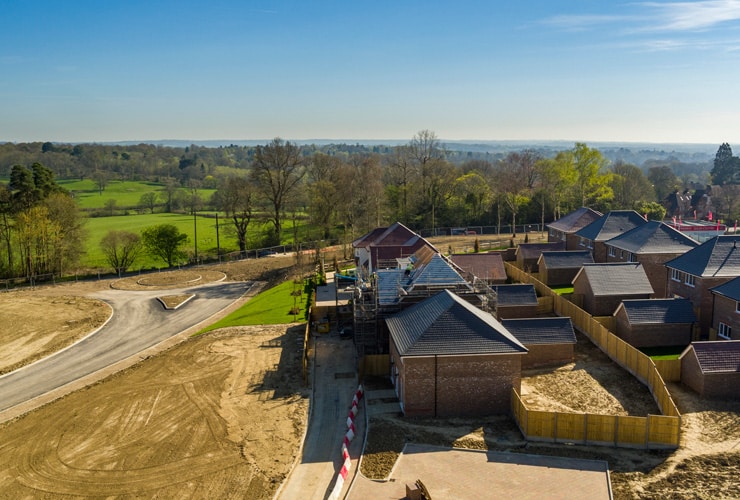Curtilage Meaning: Understanding Property Boundaries
Curtilage is an important concept for property owners.
The definition of curtilage is simple
the enclosed area of land adjacent to a dwelling house
source: Collins dictionary
Yet the dictionary definition of it and the true meaning of curtilage only tell part of the story, as it is something that is frequently misunderstood and in practice can be quite hard to define for each specific property.
So here is a useful explanation of what curtilage is as well as some important issues and problems that can occur that property and land owners should be looking out for.

-
by Robert Jones, Founder of Property Investments UK
With two decades in UK property, Rob has been investing in buy-to-let since 2005, and uses property data to develop tools for property market analysis.
So What is Curtilage?
Curtilage is usually considered to be an enclosed piece of land that is immediately next to a property and which belongs to it.
The curtilage of a 'dwelling' (dwelling is a technical term usually used to describe a residential property) might be a yard or garden as well as any outbuildings belonging to the property.
Curtilage can apply to residential properties where it is known as residential curtilage and other properties like commercial buildings and land.
The Meaning of Curtilage for Listed Properties
Interestingly curtilage can also have listed status. A grade two listed building for example can mean the aspects surrounding the property are also listed.
Here is a summary from English Heritage that explains what the curtilage law is in the UK
The law provides that buildings and other structures that pre-date July 1948 and are within the curtilage of a listed building are to be treated as part of the listed building.
Source: English Heritage
These other structures can include:
- Boundary walls
- Railings and gates
- Outbuildings
- Farm buildings
- Coach houses and stables
- Garages
- Lodges
- Workers cottages
It's important to note that not all of these will show up in standard 'searches' when you buy the property.
Also, if a building is a listed building, then it is necessary to get listed building consent from the local planning authority to carry out work, make changes or demolish it.
On occasion disputes can occur, for example, where a property owner considers that they do not need listed building consent to carry out work on other structures because they are outside the listed building’s curtilage. However, if the local planning authority considers it is within the curtilage, then listed building consent is needed.
The National Heritage List for England (NHLE) is the official, up-to-date register of all nationally protected historic buildings and sites in England. It shows those buildings and sites which are grade I, grade II and grade II* listed. Scotland and Wales have similar registers.
So if you are buying a listed building, and wish to check exactly what the boundary and curtilage is, and therefore what is listed, then working with an experienced conveyancer is very important. These properties require specialist knowledge and although you might be asking, can you do property searches yourself? DIY conveyancing is not advised here.

What is the Difference Between a Garden and a Curtilage?
The dictionary definition of curtilage (as above) talks about land in the general term.
So in the case of a house, the garden would be part of this 'land'. This can sometimes be thought of, as the boundary of the curtilage of the dwellinghouse.
Other aspects like the garage and the driveway would generally all be considered within the curtilage of the building. As could the items listed above under the curtilage listed status.
If the house had an adjoining fenced field or paddock this might not necessarily be within the curtilage even though it is in the same ownership as the house and it could indeed be on a different title plan with HM Land Registry.
How is Curtilage Identified?
England and Wales
In England and Wales, a number of factors may be taken into consideration when identifying the curtilage of a house.
Past legal cases have helped to define more clearly what curtilage is and is not.
For example, back in 1983 as a result of a court case referred to as Sutcliffe and Others v Calderdale Borough Council the Court of Appeal decided that there were three factors to take into consideration when identifying the curtilage of a property. These were:
- the physical layout of the property
- its ownership, past and present
- and its use or function past and present.
Scotland
In Scotland, curtilage is accepted to mean ‘land which is used for the comfortable enjoyment of a building and which serves the purpose of that building in some necessary or reasonably useful way.’
So is Curtilage Defined the Same for Each Property?
As above, curtilage has a dictionary definition and a meaning, considered with the factors of:
- the physical layout of the property
- its ownership, past and present
- and its use or function past and present.
Yet these factors can be a matter of interpretation.
This is why disputes occur as one party may consider that a piece of land or property is within the curtilage of a building and another party may not.
To further complicate the issue the curtilage of a property can change or be changed over time and curtilage cannot always be easily identified by looking at a map.
This is why, when buying or selling any type of property, including investment properties, proper due diligence for buying a house is essential.
So speaking with the seller, checking local searches and checking title deeds, as well as physical in person viewings, can really help to get a full understanding of the likely boundary of the curtilage of the dwellinghouse.
Curtilage 10 Year Rule
UK property and planning laws set specific timelines for enforcement action against owners who make changes without proper permissions. Curtilage definition in UK planning is impacted in the same way as the main building.
One such timeline is known as the 10 year rule, and although not specific to curtilage, it is part of the planning requirements.
Gov.uk has specific guidance here on when and how this works and specifically the 10 year rule 'time-limit'.
There is also a 4 year rule and 'time-limit in some circumstances.
However it is important to note this does not apply to listed buildings, there is no 4 year rule or 10 year rule for listed buildings and indeed there are no time-limits at all for issuing listed buildings enforcement notices in relation to a breach of planning control, so it is recommend that you do not go changing anything within the curtilage of a listed building without the required consents.
Why Curtilage is Important
Curtilage is extremely important as it can be part of the access rights to and from a property.
It can also be used to decide what can or cannot be done with a property (as is the case with listed curtilage) and what can and cannot be done without prior permission.
Remember the rights and restrictions that apply to a property often apply to its curtilage.
